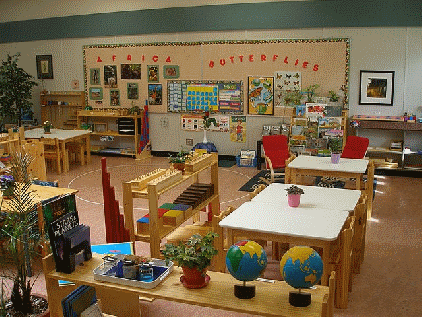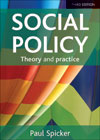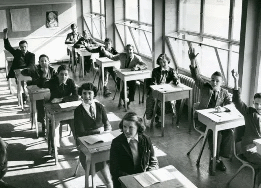
A Montessori schoolroom. This
was one of the pioneers of
'progressive' teaching methods,
both humanist and naturalist.
An introduction to Social Policy

Education is principally identified with schooling, though in theory it extends far beyond this, being concerned with intellectual and social development. The main emphasis within this is on children, though there is clearly scope for education for all and 'lifelong learning'.
Education has been particularly significant as an instrument of social policy, in the sense not only of policies for welfare but also as policies intended to deal with the structure of society. The aims of education include:
Finch refers to the use of education as a vehicle for other types of social policy. Education provides a convenient basis for policy for children because of its universal coverage, the acceptance of responsibility for children's welfare, and because it has been easy to justify welfare measures in educational terms. [1]
External link: World data on education

A Montessori schoolroom. This
was one of the pioneers of
'progressive' teaching methods,
both humanist and naturalist.
Four educational models have been influential in Europe.
The dominant models in the UK have been humanism for the elite, and vocationalism for others. French education is traditionally encyclopaedist, while Danish education has been naturalist.
There are several types of explanation for the origins of educational disadvantage.

Eton School in 1897. Tawney called the private schools "England's
hereditary curse".
(c) de Montfort University
Free elementary education was introduced in England in 1870; secondary schools were fee-paying until 1944. 80% of children left after elementary education, which after 1918 finished at 14. The 1944 Education Act introduced free secondary education.
The dominant principle was the pursuit of equality. The system was based on a 'tripartite' structure, distinguishing grammar, technical and secondary modern. Within these schools there was to be 'parity of esteem'. In practice, there were few technical schools, which meant the system was more 'bipartite' than 'tripartite'. Since grammar schools were selective, and secondary moderns took the rest, there was never 'parity of esteem'.
Non-selective or 'comprehensive' schools were introduced gradually, but comprehensive education became government policy in the 1960s. The arguments for and against comprehensive education have been confused with other arguments about educational methods and the purposes of education. The main arguments for comprehensives are they reduce the likelihood of discrimination or disadvantage on the basis of class, and that they improve the prospects of children of middling ability. The main argument against is that the selective system may be more consistent with the idea of equality of opportunity. Working class children who went to grammar schools did better than those who go now to comprehensive schools.
Primary education in Britain typically runs from 4 or 5 through to
11/12, though in some areas there are transfers to middle schools at an
earlier age (such as 8/9). Concerns with basic skills - the "3 Rs" of
Reading, wRiting and aRithmetic - and social development are often
levelled at secondary schools, but it is at primary level that these
issues are supposed to be addressed. The devasting findings of the 1999
Moser report [3], that "something like one adult in five in
this country is not
functionally literate and far more people have problems with numeracy",
has led to a renewed emphasis on basic skills, and subsequent surveys
have shown marked improvements in literacy.
The evidence in the 1950s and 1960s showed convincingly that opportunities depend on the foundation of the early years. It also strongly linked progress in school with a child's home background, and primary schooling presented one of the main opportunities to deliver other kinds of service, including health care and nutrition. The focus on deprivation led to "Educational Priority Areas", actually not areas but primary schools with greater concentrations of educational and social problems. In the 1970s, attention on the early years shifted to children of pre-school age, and education policy refocused on secondary schooling.

A secondary modern school, c. 1950.
Crown copyright.
A series of conservative critiques of the education system in the 1970s argued that
By contrast, the schools inspectorate (subsequently Ofsted in England) made a very different set of criticisms of schooling:
Most schools have no problem of discipline (though Ofsted reports comment on some deterioration in standards in secondary schools). The most common problem, identified in a fifth of schools, is truancy which is condoned by parents.
There have been four main trends in more recent reforms.
Education after school age is mainly classified as "higher" or "further" education. Higher education is focused on universities, academic and professional activity; further education is mainly for lower-achieving occupational courses, apprenticeships and entry-level academic qualifications that can lead to higher education, sometimes with second-year entry to a three-year degree. In the post-war years, higher education was mainly for an educational elite. In the 1960s the sector was greatly expanded, with a new wave of universities, and the creation of "polytechnics" which were intended to develop vocational study in professional fields such as engineering, pharmacy or teaching. The "binary divide" was seen as a distinction of status as well as function. The polytechnics moved to self-validation of degrees in the 1980s and were converted to universities in the early 1990s.
The gradual expansion of universities to occupy a mass teaching role has been accompanied by a dilution of methods rather than any fundamental redesign. To cope with the larger numbers, the numbers of interactions and assessments have fallen. Despite that, the grades given for degrees have also risen, with the upper second-class degree, a mark of distinction in the days of external validation, now being the norm. In a survey reported in the Times Higher Education Supplement, more than a third of academics express concern about falling standards [4].
External link: The Dearing report on Higher Education
Further reading
A Halsey, H Lauder, P Brown, A Wells (eds), Education: culture,
economy, society, Oxford University Press 1997
Education and skills, from the British Library's
Social Welfare Portal.